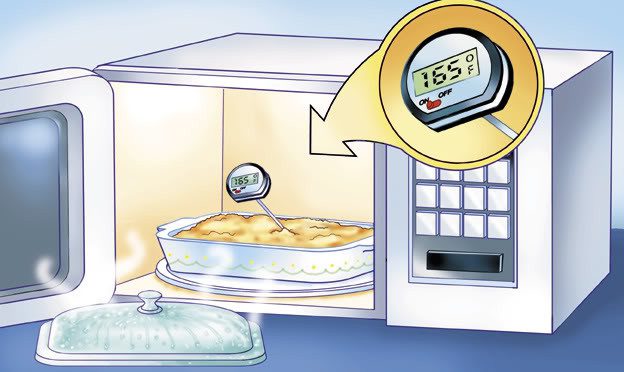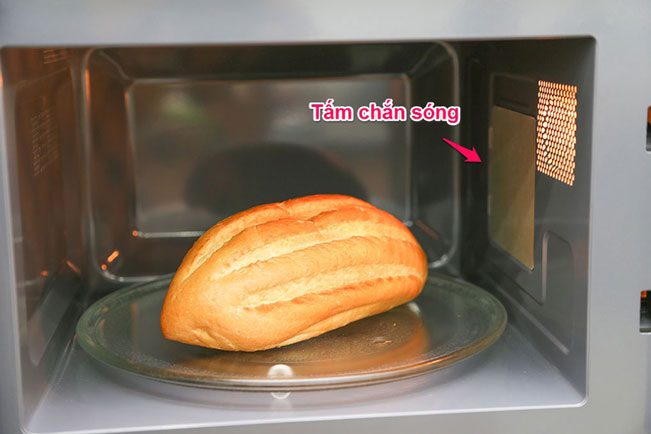Microwave ovens are becoming increasingly familiar in households; they are versatile and time-saving appliances that use microwave radiation to heat food, catering to human eating needs. You may use it daily, but have you ever wondered how it accomplishes these tasks?
Essential Information About Microwave Ovens
The following article will provide an overview of the operating principles and components of microwave ovens to help users better understand the device they are using.
Main Components of a Microwave Oven
- Cooking Chamber (usable space).
- Microcontroller.
- High-Frequency Wave Generator (magnetron) – the source of wave emission.
- Waveguide.

The metal mesh commonly observed at the microwave door.
The cooking chamber is a Faraday cage made of metal or metal mesh that ensures waves do not escape. The metal mesh is typically seen at the microwave door. The holes in this mesh are much smaller than the wavelength (12cm), allowing microwave radiation to stay contained while letting light (with a much shorter wavelength) pass through, enabling users to observe the food inside. Microwave ovens use microwave radiation to heat food.
Operating Principle
Microwave radiation is generated by an electromagnetic oscillator and amplified by the magnetron, which functions like a three-electrode vacuum tube. Energy (microwaves) from the generator (magnetron) is transmitted through the waveguide to the dispersing fan (located at the top of the oven) to distribute waves in all directions (Figure 1-21). Waves are evenly dispersed in the oven due to reflection off the oven walls. The food is heated by the water molecules within it.
Heating occurs in two stages:
- The water contained in the food is heated by the short waves.
- The heated water then transfers heat to the other parts of the food.
Magnetron Wave Emission Component
The magnetron consists of a hollow metal cylinder, with a positive electrode (anode) on the outside and resonance cavities placed inside. To increase the frequency from 50 Hz to 2450 Hz, an oscillator is used, with the essential component being the parallel resonance circuit. Each resonance cavity acts as a parallel resonance circuit.
At the center of the hollow cylinder is the negative electrode (cathode), which has a heating wire (filament).
Inside the magnetron is a vacuum, and a voltage of about 2300 volts is applied between the negative and positive electrodes to create a magnetic field. This magnetic field causes electrons to move from the negative to the positive electrode. To generate and maintain oscillations at high frequencies, the electromagnetic waves must move in a spiral path before the resonance cavities. This path is made possible by a magnetic field created by a magnet, with the field lines perpendicular to the electric field E.
In a strong electromagnetic field, water molecules align along the field lines. Under the influence of the electromagnetic field, the hydrogen and oxygen atoms change polarity 2.45 billion times per second. The friction between water molecules generates heat. Water in the food is heated rapidly and transfers energy to other components of the food, thus heating the entire dish.
Microwave Not Heating: Causes and Solutions
Using Non-Microwave-Safe Containers
Using inappropriate containers in your microwave is one of the reasons it may not heat food, and it can also affect the microwave’s lifespan. To avoid using the wrong containers, opt for ceramic, glass, or microwave-specific containers to ensure the microwave stays undamaged during operation.
Avoid using metal containers, as they can cause sparks to fly out of the microwave, preventing it from heating. Consequently, the food does not receive heat and cannot be defrosted.
Wave Shield or Fuse Malfunction
How to Identify: If the light inside the microwave is on, and the food tray is still turning, but the food is not heating, this means the wave shield in your microwave is malfunctioning.

Check the wave shield if your microwave is not heating.
Causes: Frequent use of the microwave over an extended period can lead to overload, preventing it from dissipating heat. At that point, the microwave’s fuse will blow to protect the high-frequency bulb.
Solutions:
You can unplug the microwave, open the door, remove all the food, and then proceed to take off the outer back cover of the microwave.
Next, locate the fuse box and remove it.
After taking out the fuse box, open it and use a multimeter to check if the two wire ends connected to the fuse light up. If the light does not turn on, it means the fuse has blown, and you need to replace it with a fuse of the same type.
Once you have replaced the fuse, reinstall it in its original position, plug it back in, and use the microwave as usual.
Microwave Too Dirty, Affecting Wave Shield
How to Identify: If the interior of the microwave is caked with dirt and it is not heating.
Causes: If you frequently use the microwave for cooking, defrosting, or reheating food but don’t clean it for months, bacteria and dirt can accumulate, impeding the emission of waves.
Cleaning the Microwave After Use: Use a soft cloth soaked in warm water to wipe the microwave’s interior and exterior to disinfect and remove leftover food stains. If your microwave has stubborn stains that cannot be cleaned with a warm cloth, you can also use lemon, vinegar, or other cleaning agents for easier cleaning.
Deodorizing the Microwave: After using the microwave for cooking or defrosting, it may retain food odors. To eliminate these odors, use a cup of fresh lemon juice and microwave it for about 3 minutes, then clean the microwave again to ensure it operates at its best.





















































